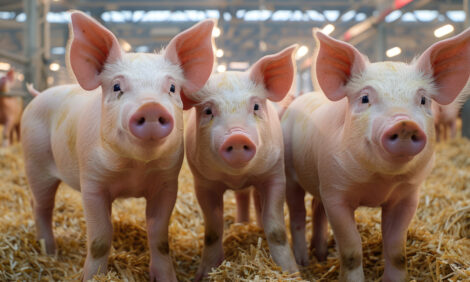



Comfortable sows make more pigs.
By Tim Safranski, MU extension swine reproduction specialist. This article presents a number of sow-care techniques to increase litter size. Reducing stress in the first 14 days of gestation is the key.Keeping sows comfortable, especially in the early days after breeding, can reduce embryonic death loss, said Tim Safranski, MU extension swine reproduction specialist. Reducing stress, especially during the first 14 days of gestation, helps sows retain more of the fertilized eggs.
Far more eggs are fertilized than survive to live births, Safranski said. Tender care can make a difference in increasing survival, he told the sold-out crowd. Registration for the school was limited to 50.
"I was really pleased with the participation," said Darla Eggers of the Missouri Pork Producers Association, Columbia, a sponsor of the event. "We had representatives from all sizes and kinds of operations."
Eggers noted the good discussion by participants. "We all learn, even the instructors, when sharing information."
The school was made possible for producers with funding from the Pork Check-off Program, Eggers said.
Safranski said early embryonic death loss is much higher than most producers realize. A sow normally produces about 20 eggs. But, hog farm records show that the average litter size at birth is 11 pigs. By weaning time that average is down to 8.8 pigs per litter.
"The biggest loss is an unseen loss," Safranski said. "Those embryonic deaths are never noticed." An abortion, in which the embryo is expelled is much more visible, although less frequent, he added.
Many kinds of stress reduce the embryonic survival rate. Stress includes improper diet, too much heat, fighting, and disease.
Fighting, for example, can reduce litter size even if there is no physical injury. Fighting induces as sudden shift in the sow's hormonal balance.
The hormone progesterone is most responsible for maintaining pregnancy. However, when fighting, cortisol hormone levels can shoot up. That in turn lowers progesterone, causing loss of embryos.
Fights are likely to occur if sows are mixed in a pen right after breeding. In a group, sows fight to establish the social order and determine the boss sow.
Putting newly bred sows in individual crates can reduce physical activity and stress. Keeping sows in crates for 30 days gets them through the most critical stage of early pregnancy, but 45 days would be better.
If sows are grouped, Safranski suggested keeping groups small.
Even the first 10 minutes after breeding can be critical. "Let the sow stand quietly, alone for a few minutes," Safranski said. "Give her time to know that she has been inseminated."
A change of sow diet is also needed on the day of breeding. During the nursing phase, sows should be on a high-energy diet to produce milk for their pigs. However, when weaned and re-bred, the sow should be put on a reduced energy diet. That is especially important during the first four days of gestation.
Nutrients from a high-energy ration must be processed by the sow, increasing the blood flow through the liver. That in turn increases the chances for the liver to filter out more of the progesterone needed to maintain pregnancy. "Less feed reduces the work for the liver and keeps progesterone levels high," Safranski said.
Heat stress is especially harmful to the early attachment of the embryo to the wall of the uterus, Safranski said. That is one reason why conception rates go down during summer months.
Overall, Safranski said. It is important to know what is going on in the uterus and the hormonal cycles of the sow during the gestation period.
"Design a management system that reinforces the hormonal cycles that sustain pregnancy."
Source: Tim Safranski (573) 882-7327








